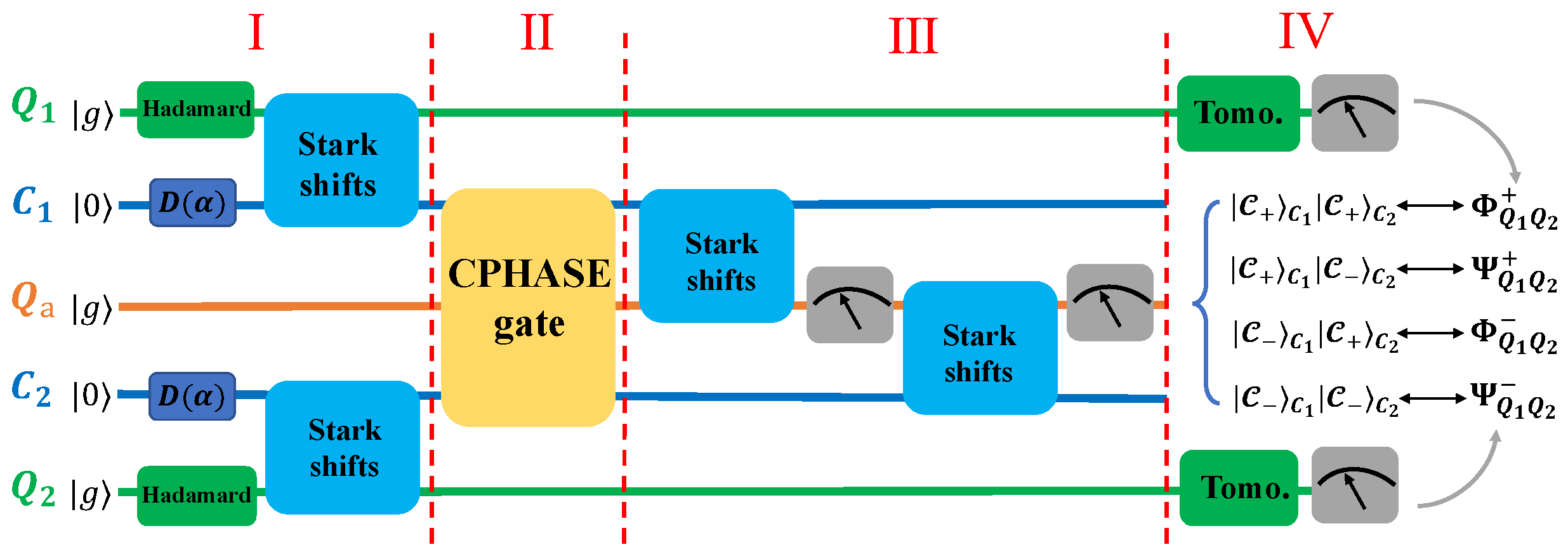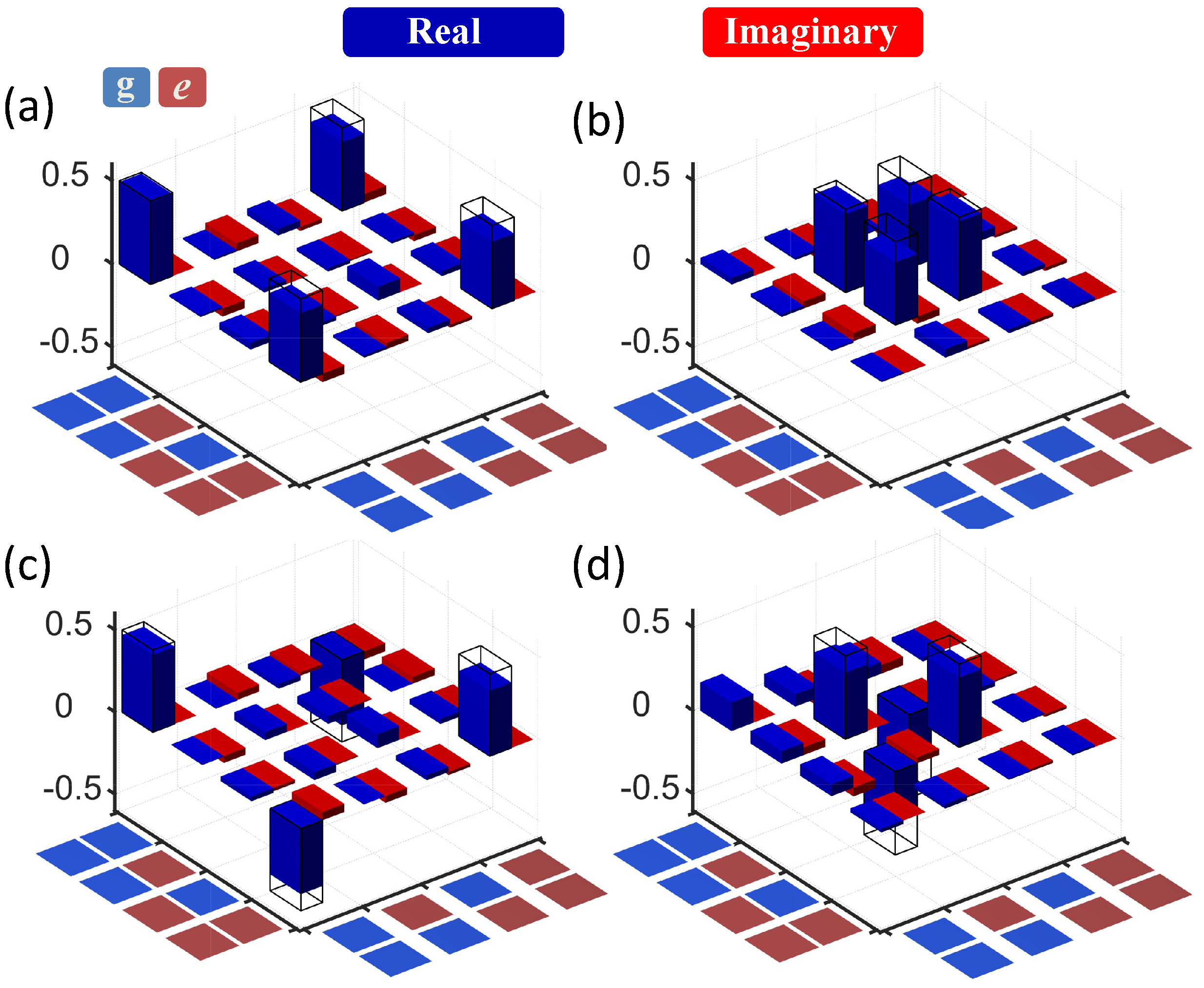Deterministic Entanglement Swapping with Hybrid Discrete- and Continuous-Variable Systems
Abstract
:1. Introduction
2. Preparation of Hybrid Entangled States in Two Subsystems
3. The State Conversion of the Two Cavities: From the Entangled State Elements to the Direct Product Elements
4. Distinguishing the States of the Two Cavities
5. Conclusions
Author Contributions
Funding
Institutional Review Board Statement
Informed Consent Statement
Data Availability Statement
Conflicts of Interest
References
- Einstein, A.; Podolsky, B.; Rosen, N. Can Quantum-Mechanical Description of Physical Reality Be Considered Complete? Phys. Rev. 1935, 47, 777–780. [Google Scholar] [CrossRef] [Green Version]
- Bell, J.S. On the Einstein Podolsky Rosen paradox. Phys. Phys. Fiz. 1964, 1, 195–200. [Google Scholar] [CrossRef] [Green Version]
- Clauser, J.F.; Horne, M.A.; Shimony, A.; Holt, R.A. Proposed Experiment to Test Local Hidden-Variable Theories. Phys. Rev. Lett. 1969, 23, 880–884. [Google Scholar] [CrossRef] [Green Version]
- Bennett, C.H.; Brassard, G.; Crépeau, C.; Jozsa, R.; Peres, A.; Wootters, W.K. Teleporting an unknown quantum state via dual classical and Einstein-Podolsky-Rosen channels. Phys. Rev. Lett. 1993, 70, 1895–1899. [Google Scholar] [CrossRef] [PubMed] [Green Version]
- Raussendorf, R.; Briegel, H.J. A One-Way Quantum Computer. Phys. Rev. Lett. 2001, 86, 5188–5191. [Google Scholar] [CrossRef]
- Żukowski, M.; Zeilinger, A.; Horne, M.A.; Ekert, A.K. “Event-ready-detectors” Bell experiment via entanglement swapping. Phys. Rev. Lett. 1993, 71, 4287–4290. [Google Scholar] [CrossRef]
- Andersen, U.L.; Neergaard-Nielsen, J.S.; van Loock, P.; Furusawa, A. Hybrid discrete- and continuous-variable quantum information. Nat. Phys. 2015, 11, 713–719. [Google Scholar] [CrossRef] [Green Version]
- Pan, J.W.; Bouwmeester, D.; Weinfurter, H.; Zeilinger, A. Experimental Entanglement Swapping: Entangling Photons That Never Interacted. Phys. Rev. Lett. 1998, 80, 3891–3894. [Google Scholar] [CrossRef]
- Pan, J.W.; Daniell, M.; Gasparoni, S.; Weihs, G.; Zeilinger, A. Experimental Demonstration of Four-Photon Entanglement and High-Fidelity Teleportation. Phys. Rev. Lett. 2001, 86, 4435–4438. [Google Scholar] [CrossRef] [Green Version]
- de Riedmatten, H.; Marcikic, I.; van Houwelingen, J.A.W.; Tittel, W.; Zbinden, H.; Gisin, N. Long-distance entanglement swapping with photons from separated sources. Phys. Rev. A 2005, 71, 050302. [Google Scholar] [CrossRef] [Green Version]
- Halder, M.; Beveratos, A.; Gisin, N.; Scarani, V.; Simon, C.; Zbinden, H. Entangling independent photons by time measurement. Nat. Phys. 2007, 3, 692–695. [Google Scholar] [CrossRef] [Green Version]
- Lu, C.Y.; Yang, T.; Pan, J.W. Experimental Multiparticle Entanglement Swapping for Quantum Networking. Phys. Rev. Lett. 2009, 103, 020501. [Google Scholar] [CrossRef] [PubMed]
- Schmid, C.; Kiesel, N.; Weber, U.K.; Ursin, R.; Zeilinger, A.; Weinfurter, H. Quantum teleportation and entanglement swapping with linear optics logic gates. New J. Phys. 2009, 11, 033008. [Google Scholar] [CrossRef]
- Sciarrino, F.; Lombardi, E.; Milani, G.; De Martini, F. Delayed-choice entanglement swapping with vacuum–one-photon quantum states. Phys. Rev. A 2002, 66, 024309. [Google Scholar] [CrossRef] [Green Version]
- Jennewein, T.; Weihs, G.; Pan, J.W.; Zeilinger, A. Experimental Nonlocality Proof of Quantum Teleportation and Entanglement Swapping. Phys. Rev. Lett. 2001, 88, 017903. [Google Scholar] [CrossRef] [Green Version]
- Ma, X.; Zotter, S.; Kofler, J.; Ursin, R.; Jennewein, T.; Brukner, Č.; Zeilinger, A. Experimental delayed-choice entanglement swapping. Nat. Phys. 2012, 8, 479–484. [Google Scholar] [CrossRef] [Green Version]
- Megidish, E.; Halevy, A.; Shacham, T.; Dvir, T.; Dovrat, L.; Eisenberg, H.S. Entanglement Swapping between Photons that have Never Coexisted. Phys. Rev. Lett. 2013, 110, 210403. [Google Scholar] [CrossRef] [Green Version]
- Riebe, M.; Monz, T.; Kim, K.; Villar, A.S.; Schindler, P.; Chwalla, M.; Hennrich, M.; Blatt, R. Deterministic entanglement swapping with an ion-trap quantum computer. Nat. Phys. 2008, 4, 839–842. [Google Scholar] [CrossRef]
- Ning, W.; Huang, X.J.; Han, P.R.; Li, H.; Deng, H.; Yang, Z.B.; Zhong, Z.R.; Xia, Y.; Xu, K.; Zheng, D.; et al. Deterministic Entanglement Swapping in a Superconducting Circuit. Phys. Rev. Lett. 2019, 123, 060502. [Google Scholar] [CrossRef] [Green Version]
- Peres, A. Delayed choice for entanglement swapping. J. Mod. Opt. 2000, 47, 139–143. [Google Scholar] [CrossRef]
- Jia, X.; Su, X.; Pan, Q.; Gao, J.; Xie, C.; Peng, K. Experimental Demonstration of Unconditional Entanglement Swapping for Continuous Variables. Phys. Rev. Lett. 2004, 93, 250503. [Google Scholar] [CrossRef] [PubMed] [Green Version]
- Takei, N.; Yonezawa, H.; Aoki, T.; Furusawa, A. High-Fidelity Teleportation beyond the No-Cloning Limit and Entanglement Swapping for Continuous Variables. Phys. Rev. Lett. 2005, 94, 220502. [Google Scholar] [CrossRef] [PubMed] [Green Version]
- Wen, J.; Novikova, I.; Qian, C.; Zhang, C.; Du, S. Hybrid Entanglement between Optical Discrete Polarizations and Continuous Quadrature Variables. Photonics 2021, 8, 552. [Google Scholar] [CrossRef]
- Takeda, S.; Fuwa, M.; van Loock, P.; Furusawa, A. Entanglement Swapping between Discrete and Continuous Variables. Phys. Rev. Lett. 2015, 114, 100501. [Google Scholar] [CrossRef] [Green Version]
- Riebe, M.; Häffner, H.; Roos, C.F.; Hänsel, W.; Benhelm, J.; Lancaster, G.P.T.; Körber, T.W.; Becher, C.; Schmidt-Kaler, F.; James, D.F.V.; et al. Deterministic quantum teleportation with atoms. Nature 2004, 429, 734–737. [Google Scholar] [CrossRef]
- Barrett, M.D.; Chiaverini, J.; Schaetz, T.; Britton, J.; Itano, W.M.; Jost, J.D.; Knill, E.; Langer, C.; Leibfried, D.; Ozeri, R.; et al. Deterministic quantum teleportation of atomic qubits. Nature 2004, 429, 737–739. [Google Scholar] [CrossRef]
- Baur, M.; Fedorov, A.; Steffen, L.; Filipp, S.; da Silva, M.P.; Wallraff, A. Benchmarking a Quantum Teleportation Protocol in Superconducting Circuits Using Tomography and an Entanglement Witness. Phys. Rev. Lett. 2012, 108, 040502. [Google Scholar] [CrossRef]
- Steffen, L.; Salathe, Y.; Oppliger, M.; Kurpiers, P.; Baur, M.; Lang, C.; Eichler, C.; Puebla-Hellmann, G.; Fedorov, A.; Wallraff, A. Deterministic quantum teleportation with feed-forward in a solid state system. Nature 2013, 500, 319–322. [Google Scholar] [CrossRef] [Green Version]
- Wendin, G. Quantum information processing with superconducting circuits: A review. Rep. Prog. Phys. 2017, 80, 106001. [Google Scholar] [CrossRef] [Green Version]
- Joo, J.; Ginossar, E. Efficient scheme for hybrid teleportation via entangled coherent states in circuit quantum electrodynamics. Sci. Rep. 2016, 6, 26338. [Google Scholar] [CrossRef] [Green Version]
- Ran, D.; Hu, C.S.; Yang, Z.B. Entanglement transfer from two-mode continuous variable SU(2) cat states to discrete qubits systems in Jaynes-Cummings Dimers. Sci. Rep. 2016, 6, 32089. [Google Scholar] [CrossRef] [PubMed]
- Brune, M.; Hagley, E.; Dreyer, J.; Maître, X.; Maali, A.; Wunderlich, C.; Raimond, J.M.; Haroche, S. Observing the Progressive Decoherence of the “Meter” in a Quantum Measurement. Phys. Rev. Lett. 1996, 77, 4887–4890. [Google Scholar] [CrossRef] [Green Version]
- Brune, M.; Nussenzveig, P.; Schmidt-Kaler, F.; Bernardot, F.; Maali, A.; Raimond, J.M.; Haroche, S. From Lamb shift to light shifts: Vacuum and subphoton cavity fields measured by atomic phase sensitive detection. Phys. Rev. Lett. 1994, 72, 3339–3342. [Google Scholar] [CrossRef] [PubMed]
- Vlastakis, B.; Kirchmair, G.; Leghtas, Z.; Nigg, S.E.; Frunzio, L.; Girvin, S.M.; Mirrahimi, M.; Devoret, M.H.; Schoelkopf, R.J. Deterministically Encoding Quantum Information Using 100-Photon Schrodinger Cat States. Science 2013, 342, 607–610. [Google Scholar] [CrossRef] [PubMed]
- Sun, L.; Petrenko, A.; Leghtas, Z.; Vlastakis, B.; Kirchmair, G.; Sliwa, K.M.; Narla, A.; Hatridge, M.; Shankar, S.; Blumoff, J.; et al. Tracking photon jumps with repeated quantum non-demolition parity measurements. Nature 2014, 511, 444–448. [Google Scholar] [CrossRef]
- Xu, Y.; Ma, Y.; Cai, W.; Mu, X.; Dai, W.; Wang, W.; Hu, L.; Li, X.; Han, J.; Wang, H.; et al. Demonstration of Controlled-Phase Gates between Two Error-Correctable Photonic Qubits. Phys. Rev. Lett. 2020, 124, 120501. [Google Scholar] [CrossRef] [Green Version]
- Wang, C.; Gao, Y.Y.; Reinhold, P.; Heeres, R.W.; Ofek, N.; Chou, K.; Axline, C.; Reagor, M.; Blumoff, J.; Sliwa, K.M.; et al. A Schrodinger cat living in two boxes. Science 2016, 352, 1087–1091. [Google Scholar] [CrossRef] [Green Version]
- Ma, Y.; Pan, X.; Cai, W.; Mu, X.; Xu, Y.; Hu, L.; Wang, W.; Wang, H.; Song, Y.P.; Yang, Z.B.; et al. Manipulating Complex Hybrid Entanglement and Testing Multipartite Bell Inequalities in a Superconducting Circuit. Phys. Rev. Lett. 2020, 125, 180503. [Google Scholar] [CrossRef]
- Yang, Z.B.; Han, P.R.; Huang, X.J.; Ning, W.; Li, H.; Xu, K.; Zheng, D.; Fan, H.; Zheng, S.B. Experimental demonstration of entanglement-enabled universal quantum cloning in a circuit. NPJ Quantum Inf. 2021, 7, 44. [Google Scholar] [CrossRef]
- Xu, K.; Ning, W.; Huang, X.J.; Han, P.R.; Li, H.; Yang, Z.B.; Zheng, D.; Fan, H.; Zheng, S.B. Demonstration of a non-Abelian geometric controlled-NOT gate in a superconducting circuit. Optica 2021, 8, 972. [Google Scholar] [CrossRef]
- Gardiner, C.W.; Zoller, P. Quantum Noise; Springer Series in Synergetics; Springer: Berlin/Heidelberg, Germany, 2000. [Google Scholar] [CrossRef]
- Djordjevic, I.B. Hybrid CV-DV Quantum Communications and Quantum Networks. IEEE Access 2022, 10, 23284–23292. [Google Scholar] [CrossRef]
- Liu, S.; Lou, Y.; Chen, Y.; Jing, J. All-Optical Entanglement Swapping. Phys. Rev. Lett. 2022, 128, 060503. [Google Scholar] [CrossRef] [PubMed]



| Qubit 1 | Qubit 2 | Qubit a | Cavity 1 | Cavity 2 | |
|---|---|---|---|---|---|
| (s) | 35 | 20 | 25 | 480 | 692 |
| (s) | 39 | 17 | 50 | 1338 | 402 |
| (MHz) | 1.599 | 0.524 | |||
| (MHz) | 2.670 | 1.494 |
Publisher’s Note: MDPI stays neutral with regard to jurisdictional claims in published maps and institutional affiliations. |
© 2022 by the authors. Licensee MDPI, Basel, Switzerland. This article is an open access article distributed under the terms and conditions of the Creative Commons Attribution (CC BY) license (https://creativecommons.org/licenses/by/4.0/).
Share and Cite
Yang, S.-B.; Ning, W.; Zheng, R.-H.; Yang, Z.-B.; Zheng, S.-B. Deterministic Entanglement Swapping with Hybrid Discrete- and Continuous-Variable Systems. Photonics 2022, 9, 368. https://doi.org/10.3390/photonics9060368
Yang S-B, Ning W, Zheng R-H, Yang Z-B, Zheng S-B. Deterministic Entanglement Swapping with Hybrid Discrete- and Continuous-Variable Systems. Photonics. 2022; 9(6):368. https://doi.org/10.3390/photonics9060368
Chicago/Turabian StyleYang, Shou-Bang, Wen Ning, Ri-Hua Zheng, Zhen-Biao Yang, and Shi-Biao Zheng. 2022. "Deterministic Entanglement Swapping with Hybrid Discrete- and Continuous-Variable Systems" Photonics 9, no. 6: 368. https://doi.org/10.3390/photonics9060368
APA StyleYang, S.-B., Ning, W., Zheng, R.-H., Yang, Z.-B., & Zheng, S.-B. (2022). Deterministic Entanglement Swapping with Hybrid Discrete- and Continuous-Variable Systems. Photonics, 9(6), 368. https://doi.org/10.3390/photonics9060368





